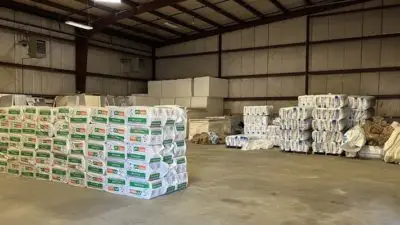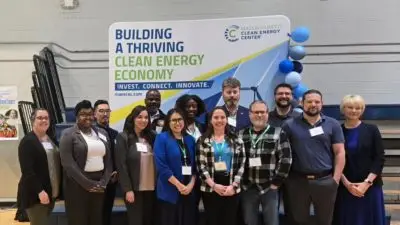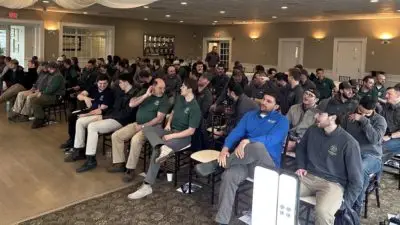If you own or rent an older home, there is a chance that you might find vermiculite insulation in your attic. Whether you’ve always been aware that your home is insulated with vermiculite, or you just found out during your Mass Save® Home Energy Assessment, it’s important to understand what’s under your roof.
What is vermiculite?
Did you know that vermiculite can actually be traced back to Worcester, Massachusetts? In 1824, Thomas H. Webb recognized the mineral and gave it the name “vermiculite” because he thought it resembled worms (in Latin, vermis = worm, vermiculare = to breed worms).
Vermiculite is a naturally occurring mineral that resembles flakes or pebbles and can look gray, brown, silver, or gold in color. It expands when heated, and according to the U.S. Environmental Protection Agency (EPA), the shiny flakes or pebbles can grow up to 8-30 times their original size.
Beyond insulation, vermiculite is considered advantageous in packaging, passive fire protection, swimming pool liners, potting soil, kilns, vehicle brake linings, and more. It is characterized as lightweight, fire-resistant, non-reactive, and highly absorbent.
Is vermiculite insulation safe?
Vermiculite on its own is safe, especially if we’re speaking about vermiculite by today’s standards.
The main concern with vermiculite insulation is that it was more than likely contaminated by asbestos. If your home was insulated between 1920 and 1991, there is a very high probability that the vermiculite in your attic or walls contains asbestos fibers.
You’re probably wondering how asbestos crossed paths with vermiculite.
The first vermiculite mining effort on record was in Colorado in 1915, but it didn’t stay open for long. In 1923, the first successful mine was started in Libby, Montana, and it remained in business until 1990.
The mine in Libby, Montana was the source of more than 70% of the vermiculite sold in the U.S. between 1919 and 1990. The problem is that there were also deposits of asbestos at that same mine, which means that the vermiculite was contaminated with asbestos.
What are the health risks of asbestos exposure?
While the town of Libby, Montana, is now deemed safe by the EPA, it was declared a public health emergency in 2009 and at the time called “the worst case of industrial poisoning of a community in U.S. history,” according to asbestos.com. It is also said to be the “largest, longest-running asbestos cleanup project in [U.S.] history.”
The health risk of asbestos exposure comes from the inhalation of airborne asbestos fibers, which is why it’s so crucial to not disturb the vermiculite in your home – that would release the fibers into the air that you breathe.
According to the EPA, asbestos exposure is connected to lung diseases like asbestosis, lung cancer, and mesothelioma, and illness can show up years, even decades, after exposure.
The mine in Libby was shut down in 1990, and by 2010, almost 50% of screened Libby residents were diagnosed with asbestos-related diseases. By 2022, almost 3,000 more people who had lived or worked in Libby were added to that list. To put that number into perspective, the town of Libby only has a population of 2,775, according to the 2020 U.S. census, and that number has remained steady over decades (the population in 1990 was 2,773).
Almost 700 residents of Libby, Montana, have died of asbestos-related complications, according to a recent study in the Journal of Exposure Science and Environmental Epidemiology, and at least 1 out of 10 Libby residents has an asbestos-related illness currently.
Do you have vermiculite insulation in your home?
The EPA states that if your home contains vermiculite insulation, you should assume that it was exposed to asbestos, and you should not move or disturb it in any way.
According to the EPA, if you have vermiculite in your attic:
- Do not disturb vermiculite insulation
- Do not store things in your attic
- Do not allow children to play in the attic
- Do not remove the insulation without a professional
Are there discounts in Massachusetts to remove vermiculite insulation?
The insulation in your attic is crucial to the energy efficiency of your home. If you plan to upgrade your insulation to save energy and money, and you currently have vermiculite insulation in your home, you could qualify for 0% financing from the Sponsors of the Mass Program to have it removed safely.
Want to learn more about the current insulation in your home or curious about upgrading? Schedule a no-cost Home Energy Assessment! A Home Energy Specialist will assess your insulation and show you how to access 75%-100% off insulation upgrades through the Mass Save program. Call Mass Save Partner, HomeWorks Energy, at (781) 305-3319 or schedule your assessment online here.
Already had an assessment? Call us to schedule your upgrade – we can talk discounts and 0% financing. HomeWorks Energy is a Home Performance Contractor and a one-stop-energy-efficiency-shop, and we can help you with your insulation needs.
Sources:
Environmental Protection Agency
Environmental Protection Agency
U.S. Department of the Interior








